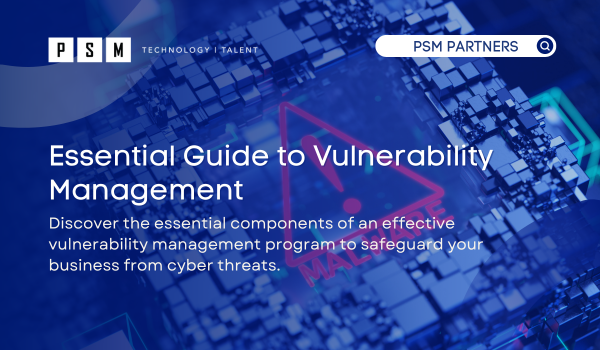Table of Contents
ToggleIn today’s increasingly digital world, protecting your organization from cyber threats is more critical than ever. A well-implemented vulnerability management program is a proactive and continuous approach to safeguarding your systems, networks, and applications from potential attacks. By identifying and addressing vulnerabilities early, businesses can reduce their overall risk exposure, prevent costly data breaches, and maintain compliance with industry security standards. This blog explores the key components, lifecycle phases, and benefits of an effective vulnerability management process, and why it’s essential for every organization’s cybersecurity strategy.
What is Vulnerability Management Program?
A vulnerability management program is a continuous, proactive, and automated approach designed to protect your computer systems, networks, and enterprise applications from cyberattacks and data breaches. The primary goal of such a program is to reduce your organization’s overall risk exposure by identifying, prioritizing, and mitigating as many vulnerabilities as possible. Vulnerability management platforms play a crucial role in this program by assessing, prioritizing, and resolving security vulnerabilities, providing risk ratings, scoring vulnerabilities, facilitating reporting metrics, and supporting a continuous lifecycle approach involving multiple workflows. However, managing vulnerabilities can be challenging due to the vast number of potential threats and the limited resources available for remediation. By leveraging a variety of tools and strategies, vulnerability management helps safeguard your systems and minimize the risk of cyberattacks.
How Whaling Attacks Deceive and Exploit Their Targets
Whaling phishing attacks typically begin with an email that appears to come from a trusted source, such as a partner, vendor, or customer account. The email is crafted with enough personal details to convince the recipient of its legitimacy. Often, the message will include a malicious link to a spoofed site that closely resembles the real one. Once the victim clicks the link, attackers can collect sensitive information or install malware. Victims may be prompted to share critical details like payroll information, tax returns, bank account numbers, or even authorize a wire transfer. The ultimate goal of these attacks is to steal money, sensitive data, or gain access to networks, leading to even more significant financial or informational breaches.
Understanding Security Vulnerabilities
Security vulnerabilities are technological weaknesses that can be exploited by attackers to compromise a product and the information it holds. These vulnerabilities can manifest in various forms, including software bugs, misconfigurations, and design flaws. Understanding security vulnerabilities is crucial for organizations to prioritize potential threats and minimize their “attack surface.”
Security vulnerabilities can be categorized into different types:
- Network Vulnerabilities: These are weaknesses in network protocols, devices, and configurations. Examples include open ports, weak encryption, and insecure network protocols.
- Application Vulnerabilities: These are flaws in software applications, including web applications and mobile apps. Common examples are SQL injection, cross-site scripting (XSS), and buffer overflows.
- System Vulnerabilities: These are weaknesses in operating systems, firmware, and hardware. Examples include outdated software, unpatched systems, and insecure default configurations.
- Human Vulnerabilities: These are weaknesses in human behavior, such as falling victim to phishing and social engineering attacks. Examples include clicking on malicious links, using weak passwords, and failing to follow security protocols.
By understanding these different types of security vulnerabilities, organizations can better identify and prioritize threats, ultimately enhancing their overall cybersecurity posture.
Key Components of an Effective Vulnerability Management Program
A comprehensive vulnerability management program consists of several critical components that work together to secure an organization’s digital environment. Here’s a breakdown of these essential elements:
Vulnerability management tools are crucial in this program, providing features like vulnerability scanning, continuous assessments, and real-time visibility to identify and remediate security weaknesses.
Asset Discovery and Inventory
Effective vulnerability management starts with a thorough understanding of all assets across the company’s digital landscape. IT teams are responsible for tracking and maintaining records of devices, software, servers, and more. Given the complexity of most organizations—often managing thousands of assets across multiple locations—this task can be daunting. That’s why many IT professionals use asset inventory management systems, which provide clear visibility into what assets exist, where they are located, and how they are being utilized. This visibility is crucial for identifying and managing identified vulnerabilities effectively.
Vulnerability Management Tools
Vulnerability scanners play a key role by conducting tests on systems and networks to identify weaknesses. These tools search for common vulnerabilities, attempt to exploit known vulnerabilities, guess default passwords, and try to gain access to restricted areas. The goal is to uncover as many vulnerabilities as possible before attackers do.
Patch Management
Keeping systems up to date is crucial for security, and patch management tools simplify this process. These tools automatically check for security updates and alert users when new patches are available. Additionally, they often allow IT teams to deploy patches across multiple systems simultaneously, ensuring that large networks remain secure without manual intervention.
Configuration Management
Security Configuration Management (SCM) software ensures that devices and systems are configured securely, tracking any changes to security settings and maintaining compliance with security policies. SCM tools help organizations scan for vulnerabilities, identify security weaknesses, manage remediation efforts, and generate detailed reports on security posture and compliance.
Security Incident and Event Management (SIEM)
SIEM software provides real-time visibility into an organization’s security environment. It consolidates security data and events, monitoring everything from network traffic to user activity. SIEM solutions help detect unusual activity across IT infrastructure, making it easier to respond to threats quickly and effectively.
Penetration Testing
Penetration testing tools allow IT professionals to simulate attacks and test for vulnerabilities in systems. With user-friendly graphical interfaces and automation features, these tools help identify potential weak spots that real-world attackers might exploit. By actively attempting to breach systems, organizations can better understand their vulnerabilities and address them before they are exploited.
Threat Intelligence
Threat intelligence software collects and analyzes data from various sources, such as exploit databases and security advisories. This data helps organizations track, monitor, and prioritize potential threats. By identifying trends and patterns, companies can anticipate and respond to potential attacks before they occur.
Vulnerability Remediation
Once vulnerabilities are identified, remediation is the next critical step. This process involves security teams prioritizing vulnerabilities, determining the best course of action, and generating tickets for IT teams to address the issues. Effective remediation ensures that security gaps are properly patched and that any misconfigurations are corrected to reduce risk.
Together, these components form a robust framework for managing vulnerabilities and reducing the risk of cyberattacks.
Implementing a Vulnerability Management Program
Implementing a vulnerability management program is essential for organizations to identify, assess, and remediate security vulnerabilities effectively. A comprehensive vulnerability management program should include the following components:
- Asset Discovery and Inventory: This involves tracking and maintaining records of all devices, software, servers, and more across the company’s digital environment. Knowing what assets exist and where they are located is the first step in identifying vulnerabilities.
- Vulnerability Scanning: Regular scans are conducted to identify known and potential vulnerabilities. Vulnerability scanners play a crucial role in this process, helping to uncover weaknesses before attackers do.
- Patch Management: Keeping computer systems up to date with the latest security patches is vital. Patch management tools automate the process of checking for updates and deploying patches across multiple systems.
- Configuration Management: Ensuring devices are configured securely and tracking changes to device security settings is critical. Configuration management tools help maintain compliance with security policies and manage remediation efforts.
- Security Incident and Event Management (SIEM): SIEM solutions consolidate security information and events in real-time, providing visibility into the organization’s security environment and helping to detect unusual activity.
- Penetration Testing: Simulating attacks to identify vulnerabilities and weaknesses is an important part of a vulnerability management program. Penetration testing tools help organizations understand their vulnerabilities and address them proactively.
- Threat Intelligence: Tracking, monitoring, analyzing, and prioritizing potential threats is essential. Threat intelligence software collects data from various sources to help organizations anticipate and respond to potential attacks.
- Remediation: Prioritizing vulnerabilities, identifying appropriate next steps, and generating remediation tickets are crucial for addressing security gaps. Effective remediation ensures that vulnerabilities are properly patched and misconfigurations are corrected.
By incorporating these components, organizations can implement a robust vulnerability management program that effectively identifies, assesses, and remediates security vulnerabilities.
The Vulnerability Management Lifecycle: Six Key Phases
An effective vulnerability management program follows a structured lifecycle to identify, assess, and address vulnerabilities. Here are the six key phases that organizations should follow to maintain strong cybersecurity:
A vulnerability assessment is a critical phase in this lifecycle, aimed at identifying potential risks within an organization’s IT assets.
- Discovery
The first step in the vulnerability management lifecycle is to create a comprehensive asset inventory of your organization’s network. By tracking all assets, you establish a baseline for your security posture. Automated vulnerability scans are crucial at this stage, allowing you to identify threats on a regular schedule and stay ahead of potential attacks.
- Prioritization of Assets
Not all assets are equally critical. Assign a value to each asset group based on its importance to your business. This prioritization helps focus attention on the most vital systems, ensuring that resources are directed toward protecting what matters most. It also streamlines decision-making when resource reallocation is necessary.
- Vulnerability Assessment
Once assets are prioritized, assess them to understand the risk profile of each. This involves analyzing both the criticality of the asset and its potential vulnerabilities. Based on this assessment, you can decide which risks to mitigate first, ensuring the most significant threats are addressed promptly.
- Reporting
After assessing risks, document your findings and security plan. Reporting is crucial to understanding the risk levels associated with each asset and communicating this information to stakeholders. Clear documentation also aids in tracking progress and refining your security strategy.
- Remediation
With a solid understanding of the vulnerabilities in your system, it’s time to fix the highest-risk issues. Focus on addressing the most critical vulnerabilities first, ensuring that your remediation efforts are efficient and impactful.
- Verification and Monitoring
The final phase involves continuous monitoring and verification. Regular audits and follow-up processes ensure that vulnerabilities have been properly remediated and that no new threats have emerged. Ongoing monitoring helps maintain the security of your systems over time.
By following these six phases, organizations can create a proactive and effective vulnerability management program that minimizes risk and strengthens their overall security posture.
Common Challenges in Vulnerability Management
Vulnerability management can be a complex and challenging process, especially for large and distributed organizations. Some common challenges in vulnerability management include:
- Limited Resources: Many organizations face insufficient budget, personnel, or technology to effectively manage vulnerabilities. This can hinder their ability to identify and remediate vulnerabilities promptly.
- Complexity of IT Environments: Diverse and complex IT environments can make it difficult to identify and remediate vulnerabilities. The more complex the environment, the harder it is to maintain visibility and control over all assets.
- Difficulty in Prioritizing Vulnerabilities: With so many vulnerabilities to address, it can be challenging to prioritize which ones to focus on first. Organizations need to balance the risk and impact of each vulnerability to make informed decisions.
- Limited Visibility into Cybersecurity Risk Reduction and Compliance Efforts: Lack of visibility into vulnerability management efforts can make it difficult to measure effectiveness and compliance. Organizations need clear reporting and metrics to track progress and ensure they meet regulatory requirements.
Overcoming these challenges is essential for maintaining a robust security posture and effectively managing vulnerabilities.
The Benefits of a Robust Vulnerability Management Program
A proactive vulnerability management program enables organizations to detect and resolve security issues before they escalate into major cybersecurity threats, helping to prevent costly breaches and protect their reputation. Additionally, it plays a crucial role in ensuring compliance with industry security standards and regulations by continuously monitoring and maintaining systems in line with the latest security protocols. This dual benefit strengthens both the security posture and regulatory adherence of businesses. Selecting an effective vulnerability management solution is critical for timely detection and comprehensive visibility of vulnerabilities.
- Key Advantages of a Strong Vulnerability Management Program:
- Improved Security and Control Automating vulnerability scanning makes it significantly harder for attackers to exploit weaknesses. By identifying vulnerabilities before cybercriminals do, organizations can maintain better control over their systems and reduce the risk of breaches.
- Visibility and Reporting A good vulnerability management program provides accurate and real-time reporting on the organization’s security posture. IT personnel can quickly identify potential threats and vulnerabilities, allowing for faster decision-making and remediation efforts.
- Operational Efficiency Reducing security risks leads to more efficient operations. By minimizing the chances of a breach, organizations experience less system downtime and better data protection. Additionally, an improved vulnerability management program ensures that, if an incident does occur, the recovery process is faster and more streamlined.
Protect Your Business with PSM Partners' Proactive Cybersecurity Services
At PSM Partners, we understand that managing vulnerabilities is a crucial part of protecting your business from evolving cyber threats. Our comprehensive cybersecurity services are designed to help you implement a proactive vulnerability management program tailored to your unique needs. Vulnerability management programs play a central role in addressing the challenges organizations face during their implementation and execution. From asset discovery and vulnerability assessments to remediation and continuous monitoring, our team of experts will ensure your systems remain secure and compliant. Let PSM Partners help you stay ahead of cyberattacks and safeguard your business with industry-leading cybersecurity solutions. Contact us today to learn how we can enhance your security posture and reduce your risk exposure.
Related Insights
What are LOLBins: The Growing Threat
Cybercriminals are becoming increasingly clever at turning everyday tools into...
Read MoreUpcoming Cybersecurity Events in 2026
As technology continues to evolve at a rapid pace, staying...
Read MoreCybersecurity Awareness Month: How to Protect Yourself from Online Threats
Every October, Cybersecurity Awareness Month serves as a reminder of...
Read MoreCybersecurity Trends in Higher Education: What Colleges and Universities Need to Know
Key Takeaways: Your Cybersecurity Questions Answered Higher Education Is Now...
Read MoreAbout the Author

Marisa Maiella
I'm a dynamic Marketing Coordinator with a passion for crafting compelling marketing campaigns and engaging content. Known for my creativity and strategic approach, I am committed to fostering brand growth and enhancing engagement through innovative marketing strategies.





